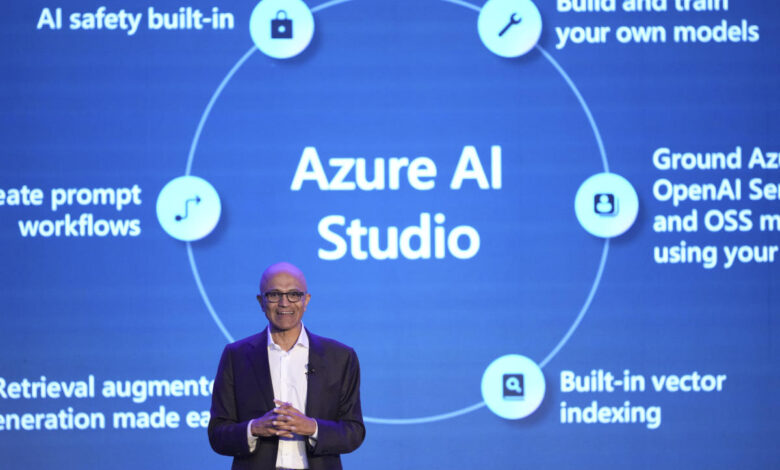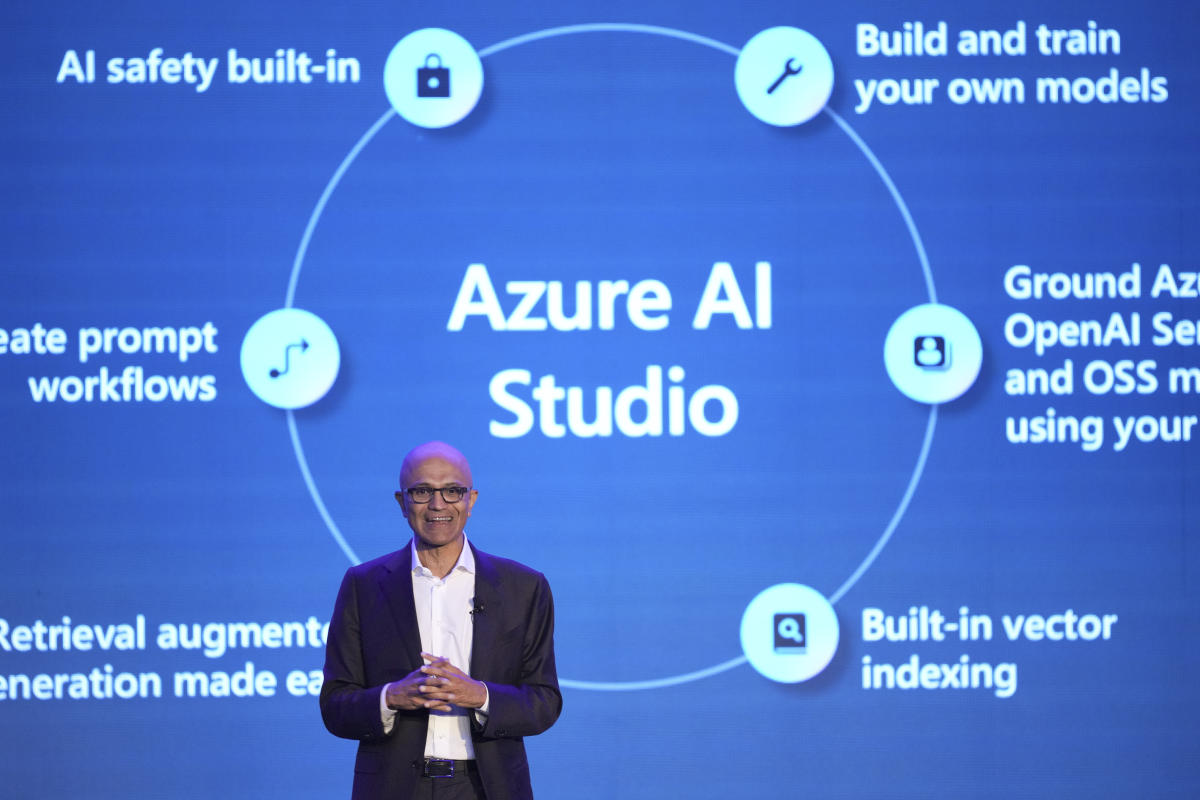
Microsoft Alerts US on Volt Typhoon Cyberattack
Microsoft alerts United States on Volt Typhoon cyber attack campaign – a chilling warning that’s sent shockwaves through the cybersecurity world. This sophisticated attack, targeting critical US infrastructure, utilizes stealthy techniques to gain persistent access and wreak havoc. We’re diving deep into the details of this alarming situation, exploring the methods used, the potential impact, and what steps can be taken to prevent future incidents.
It’s a story of advanced threats, determined attackers, and the ongoing battle to secure our digital landscape.
The Volt Typhoon campaign represents a significant escalation in the ongoing cyber warfare against the US. Its ability to infiltrate and persist within critical infrastructure highlights the need for enhanced security measures across all sectors. We’ll examine the specific vulnerabilities exploited, the actors suspected of being behind the attack, and the crucial lessons learned from this incident. Understanding the intricacies of Volt Typhoon is vital for building a more resilient and secure future.
Microsoft’s Warning
Microsoft’s recent alert regarding the Volt Typhoon cyberattack campaign highlights a significant threat to critical infrastructure in the United States. This sophisticated and persistent campaign underscores the evolving nature of cyber warfare and the need for robust cybersecurity defenses across all sectors. The scale and potential impact of this attack warrant serious attention and proactive mitigation strategies.
Volt Typhoon’s Target Infrastructure and Critical Systems
The Volt Typhoon campaign primarily targets critical infrastructure in the United States. While the full extent of targeted sectors remains under investigation, Microsoft’s findings suggest a focus on organizations within the government, telecommunications, transportation, and critical manufacturing sectors. The attackers specifically sought access to systems that could disrupt or control essential services, potentially impacting everything from power grids and water supplies to transportation networks and emergency communications.
This targeting reflects a strategic effort to inflict significant economic and societal disruption.
Methods Used by Volt Typhoon Attackers
Volt Typhoon employs a multi-stage attack process. Initial access is often achieved through compromised software supply chains or vulnerabilities in publicly exposed services. The attackers then utilize various techniques to maintain persistence within the compromised systems, including the use of custom malware and living-off-the-land techniques (LOLBins) to blend into the normal system activity. These techniques help them evade detection and maintain long-term access, enabling them to conduct reconnaissance, exfiltrate data, and potentially prepare for future disruptive actions.
The use of custom malware and the sophistication of their techniques demonstrate a high level of expertise and resources.
Potential Impact of Volt Typhoon on Essential Services and Infrastructure
The potential impact of the Volt Typhoon campaign is considerable. Successful compromise of critical infrastructure systems could lead to widespread disruptions, including power outages, communication failures, transportation delays, and disruptions to essential services like water and healthcare. Data breaches could expose sensitive information, leading to further economic and national security consequences. The long-term persistence of the attackers suggests a potential for future attacks, escalating the risk and making remediation efforts more challenging.
The potential for cascading failures across interconnected systems amplifies the overall threat.
Comparison with Other Significant Cyberattacks
The following table compares the Volt Typhoon campaign with other notable cyberattacks against US infrastructure in recent years. Note that information on specific attack techniques and impacts is often incomplete or delayed due to ongoing investigations.
| Attack Name | Target | Primary Techniques | Impact |
|---|---|---|---|
| Volt Typhoon | US Critical Infrastructure (Government, Telecom, Transportation, Manufacturing) | Supply chain compromise, LOLBins, custom malware, persistence | Potential for widespread disruption of essential services |
| SolarWinds | US Government, private sector | Supply chain compromise, malware deployment | Data breaches, espionage |
| Colonial Pipeline | US fuel pipeline | Ransomware | Fuel shortages, economic disruption |
| NotPetya | Global, significant impact on US businesses | Widespread malware propagation | Significant economic damage, business disruption |
Attribution and Actors Involved

The Volt Typhoon cyber espionage campaign, targeting critical infrastructure in the United States, has been attributed to a sophisticated threat actor operating with significant resources and advanced capabilities. Uncovering the perpetrators and understanding their motivations is crucial for developing effective defensive strategies and mitigating future risks. While definitive proof remains challenging in the complex world of cyber attribution, substantial evidence points towards a specific group with a known history of targeting US interests.The suspected actors behind the Volt Typhoon campaign are believed to be linked to the Chinese government.
Microsoft’s analysis, along with other independent research, suggests a connection to a group with a history of conducting long-term, persistent espionage operations against US targets. This attribution is based on a confluence of factors, including the sophistication of the malware, the targets’ critical infrastructure nature, and the overlaps in tactics, techniques, and procedures (TTPs) with previously observed Chinese state-sponsored cyber operations.
Suspected Actors and Their Motives
The primary motive behind Volt Typhoon appears to be espionage. The campaign’s focus on critical infrastructure sectors, including telecommunications, transportation, and energy, suggests an interest in gaining access to sensitive data and operational information related to these vital national assets. This aligns with the historical pattern of Chinese state-sponsored cyber activity, which has consistently demonstrated an interest in acquiring sensitive economic and national security information.
The long-term nature of the campaign, involving years of stealthy infiltration and data exfiltration, further reinforces the hypothesis of a sustained intelligence-gathering operation. The potential for future disruption or sabotage, although not the primary focus, remains a significant concern.
Evidence Supporting Attribution
The attribution of Volt Typhoon to a Chinese state-sponsored actor rests on several pillars of evidence. First, the malware used in the campaign, specifically the custom-built backdoor, shares similarities with tools previously associated with Chinese APT groups. Second, the targets themselves – critical infrastructure organizations across various sectors – are consistent with the known objectives of Chinese espionage operations.
Third, the TTPs employed – long-term persistence, stealthy data exfiltration, and the use of custom-built tools – are characteristic of advanced persistent threat (APT) groups often linked to nation-state actors, particularly those operating out of China. Finally, the scale and scope of the operation, requiring significant resources and expertise, point towards a state-sponsored actor with the necessary capabilities.
Comparison of TTPs with Other Known Cyber Threat Groups
While the specific TTPs of Volt Typhoon are unique in certain aspects, there are notable overlaps with other known Chinese APT groups, such as APT41 and APT10. These groups have demonstrated a similar preference for long-term persistence, using custom-built malware and exploiting vulnerabilities to gain initial access. The focus on data exfiltration, often achieved through the use of command-and-control servers located outside of the US, is also consistent across these groups.
However, Volt Typhoon demonstrates a higher level of sophistication in its ability to maintain persistence within compromised systems, often evading detection for extended periods. This showcases an evolution in Chinese APT capabilities, highlighting the continuous adaptation and improvement of their techniques.
Hypothetical Timeline of the Volt Typhoon Campaign
A hypothetical timeline might suggest initial compromises occurring as early as 2021, potentially through spear-phishing campaigns or exploiting known vulnerabilities in commonly used software. These initial footholds would have allowed the actors to establish persistent access to the victim networks. Over the following years, the attackers would likely have expanded their access, using lateral movement techniques to infiltrate deeper into the targeted organizations’ systems.
Data exfiltration would have been a continuous process, likely occurring in small batches to avoid detection. The discovery of the campaign in 2023 suggests that the operation might have been ongoing for several years, with the actors continually refining their techniques and adapting to security improvements. This highlights the enduring nature of APT campaigns and the importance of proactive threat detection and response measures.
Vulnerabilities Exploited
The Volt Typhoon campaign, attributed to a Chinese state-sponsored actor, relied on a sophisticated mix of techniques to compromise its targets. Instead of focusing on a single, massive vulnerability, the attackers employed a multi-pronged approach, leveraging several known vulnerabilities and exploiting weaknesses in network configurations and security practices. This highlights the importance of a layered security approach, as a single point of failure can be catastrophic.The attackers exploited a combination of publicly known vulnerabilities and likely zero-day exploits (unpatched vulnerabilities unknown to the public), demonstrating both their technical capabilities and their access to privileged information.
Their ability to remain undetected for extended periods suggests a level of sophistication that necessitates a proactive, rather than reactive, security posture.
Software Vulnerabilities
Microsoft’s reporting highlighted the exploitation of vulnerabilities in various software components. While specific details about zero-day exploits remain confidential for security reasons, the publicly known vulnerabilities exploited often targeted common software like VPNs, network devices, and enterprise applications. These vulnerabilities allowed the attackers to gain initial access to networks and subsequently move laterally to more sensitive systems. For example, attackers may have leveraged vulnerabilities in outdated VPN software to gain an initial foothold.
Once inside the network, they could then exploit weaknesses in other systems to expand their access.
Exploitation Techniques
The attackers didn’t just rely on automated tools. They demonstrated a high degree of manual intervention, suggesting that the campaign involved human operators conducting sophisticated reconnaissance and exploiting vulnerabilities strategically. This “human-in-the-loop” approach made it harder to detect and respond to the attack. They used techniques such as credential harvesting, lateral movement, and data exfiltration to achieve their objectives.
They may have used compromised credentials obtained through phishing or other social engineering attacks to gain access to systems. Once inside, they likely used various techniques to move laterally through the network, potentially using tools like PowerShell or other scripting languages to bypass security controls.
Mitigation Strategies
Addressing the vulnerabilities exploited by Volt Typhoon requires a multi-faceted approach. Implementing robust security measures is crucial for organizations to minimize their risk.
- Regular Software Updates and Patching: Promptly apply security updates and patches for all software, including operating systems, applications, and network devices. This is the first line of defense against known vulnerabilities.
- Strong Password Policies and Multi-Factor Authentication (MFA): Enforce strong password policies and implement MFA for all accounts, especially privileged accounts. This makes it significantly harder for attackers to gain access to systems, even if they obtain credentials through other means.
- Network Segmentation: Segment the network into smaller, isolated zones to limit the impact of a breach. If one segment is compromised, the attacker will have difficulty moving laterally to other critical systems.
- Intrusion Detection and Prevention Systems (IDS/IPS): Deploy and maintain IDS/IPS systems to detect and prevent malicious activity on the network. These systems can alert security teams to suspicious behavior and help to contain attacks.
- Security Information and Event Management (SIEM): Use a SIEM system to collect and analyze security logs from various sources. This allows for better threat detection and response capabilities.
- Regular Security Audits and Penetration Testing: Conduct regular security audits and penetration testing to identify vulnerabilities and weaknesses in the organization’s security posture. This proactive approach helps to identify and address potential threats before they can be exploited.
- Employee Security Awareness Training: Train employees on security best practices, including phishing awareness, password security, and safe browsing habits. Human error is often a key factor in successful cyberattacks.
Impact and Response

The Volt Typhoon campaign, while sophisticated and concerning, didn’t result in widespread, immediately catastrophic damage across the US. However, the long-term implications for affected organizations and the US government are significant, raising serious questions about national security and critical infrastructure resilience. The campaign’s stealthy nature and persistence mean that the full extent of the damage may not be known for some time.The immediate impact included the compromise of sensitive data and systems within targeted organizations.
This data breach potentially exposed valuable intellectual property, trade secrets, and strategic information. The disruption to operations, even if temporary, could have significant financial and reputational consequences. For the US government, the attack highlighted vulnerabilities within critical infrastructure and the potential for significant disruption to essential services. Long-term consequences include the ongoing cost of remediation, the risk of future attacks leveraging the same vulnerabilities, and the erosion of public trust in the security of government systems.
Microsoft’s Response and Mitigation Efforts
Microsoft played a crucial role in responding to the Volt Typhoon campaign. Their actions involved a multi-pronged approach focused on detection, containment, and remediation. This included the proactive identification and notification of affected customers, the development and distribution of security updates to patch exploited vulnerabilities, and the provision of technical assistance to help organizations remove the malware and secure their systems.
Beyond immediate response, Microsoft also enhanced its threat intelligence capabilities to better track and anticipate future attacks from the same actor group. They shared information with government agencies and cybersecurity partners, fostering a collaborative approach to threat mitigation.
Response Effectiveness and Collaborative Efforts
The effectiveness of the response measures is difficult to definitively assess at this stage. While Microsoft and other organizations worked diligently to contain the attack, the long-term consequences are still unfolding. The success of the response will ultimately be judged by the extent to which the vulnerabilities exploited by Volt Typhoon are mitigated, and the ability of organizations to prevent similar attacks in the future.
The collaborative response, involving information sharing between Microsoft, government agencies, and other cybersecurity firms, proved to be a critical element in mitigating the damage. This collaboration allowed for a faster and more coordinated response than might have been possible otherwise. This collaborative model, where private sector expertise is leveraged alongside governmental resources, is a crucial aspect of building a stronger national cybersecurity posture.
Visual Representation of the Attack and Response
Imagine a diagram depicting the Volt Typhoon campaign. The initial stage, represented by a dark cloud labeled “Initial Access,” shows the attackers gaining entry through compromised software or phishing attacks. This leads to the “Lateral Movement” stage, a series of expanding circles showing the malware spreading within the network. Next, “Data Exfiltration” is depicted as a data stream flowing from the compromised network to an external server, represented by a distant, ominous-looking data center.
Finally, “Persistence” is shown as roots growing deep into the system, illustrating the malware’s ability to remain hidden.The response is represented by a series of bright beams of light emanating from different points. “Microsoft Security Updates” are shown as beams striking the malware, disrupting its functionality. “Threat Intelligence Sharing” is depicted as a network connecting different security organizations, sharing information and coordinating their efforts.
“Incident Response Teams” are illustrated as figures working diligently to remove the malware and secure the affected systems. The visual emphasizes the proactive and collaborative nature of the response in contrast to the stealth and persistence of the attack.
Lessons Learned and Future Implications: Microsoft Alerts United States On Volt Typhoon Cyber Attack Campaign
The Volt Typhoon campaign, a sophisticated and long-running cyber espionage operation targeting critical infrastructure in the United States, offers crucial insights into the evolving landscape of cyber threats. Analyzing this campaign reveals significant vulnerabilities in our current cybersecurity posture and highlights the urgent need for proactive and adaptive strategies. Understanding these lessons is paramount to bolstering our national security and preventing future attacks of similar scale and impact.The Volt Typhoon campaign underscores the effectiveness of persistent, long-term intrusion strategies.
The attackers’ ability to maintain a foothold within targeted networks for extended periods, often undetected, showcases the limitations of traditional, reactive security measures. This highlights the need to shift towards a more proactive, threat-hunting approach, focusing on continuous monitoring and early detection of malicious activity, rather than solely relying on incident response after a breach.
Improved Threat Hunting Capabilities
The Volt Typhoon campaign’s success in evading detection for a considerable time emphasizes the necessity for enhancing threat hunting capabilities. This involves investing in advanced security information and event management (SIEM) systems, employing skilled threat hunters capable of analyzing large datasets for subtle indicators of compromise (IOCs), and regularly conducting red team exercises to simulate real-world attacks and identify vulnerabilities.
The focus should be on proactively identifying and neutralizing threats before they can cause significant damage. For example, incorporating artificial intelligence and machine learning algorithms into SIEM systems can significantly improve the detection of anomalous activities and accelerate the identification of potential threats.
Strengthening Critical Infrastructure Cybersecurity
The targeting of critical infrastructure highlights the vulnerability of these systems to sophisticated cyberattacks. The campaign underscores the need for stronger cybersecurity standards and regulations for critical infrastructure operators. This includes mandatory security assessments, vulnerability management programs, incident response plans, and robust cybersecurity training for personnel. Furthermore, collaboration and information sharing between private sector organizations and government agencies is crucial to building a collective defense against these attacks.
The implementation of a robust cybersecurity framework, such as the NIST Cybersecurity Framework, should be mandated and regularly audited. Real-world examples like the Colonial Pipeline ransomware attack demonstrated the devastating consequences of insufficient cybersecurity measures in critical infrastructure. Lessons learned from that event should be directly applied and expanded upon.
Enhanced Software Supply Chain Security
The Volt Typhoon campaign also highlighted the risks associated with compromised software supply chains. Attackers leveraged vulnerabilities in commonly used software to gain initial access to their targets. This emphasizes the importance of strengthening software supply chain security through rigorous vetting of third-party vendors, implementing secure software development practices, and employing robust software bill of materials (SBOMs) to track components and identify potential vulnerabilities.
Implementing stronger security measures throughout the software development lifecycle, from design to deployment, is essential to mitigate these risks. The SolarWinds attack serves as a stark reminder of the devastating consequences of compromised software supply chains, demonstrating the far-reaching impact such breaches can have.
International Collaboration and Information Sharing, Microsoft alerts united states on volt typhoon cyber attack campaign
Given the transnational nature of many cyberattacks, including Volt Typhoon, international collaboration and information sharing are crucial for effective response and prevention. Strengthening partnerships with allied nations to share threat intelligence, coordinate responses, and develop joint strategies is essential to combat these increasingly sophisticated attacks. This collaborative approach will allow for a more comprehensive understanding of the threat landscape and enable a more effective collective defense.
The sharing of IOCs and best practices among nations is essential to prevent similar attacks from succeeding in other countries. Examples of successful international collaborations in cybersecurity, such as those between Five Eyes nations, should serve as models for future partnerships.
Microsoft’s warning about the Volt Typhoon cyber attack campaign targeting the US highlights the urgent need for robust cybersecurity. Building secure and resilient applications is crucial, and that’s where understanding the power of domino app dev, the low-code and pro-code future , comes in. Efficient development practices, like those discussed in the link, can help organizations better defend against sophisticated threats like Volt Typhoon, ensuring systems are less vulnerable to exploitation.
Last Recap
The Volt Typhoon cyberattack serves as a stark reminder of the ever-evolving threat landscape. The sophisticated techniques employed, the critical infrastructure targeted, and the potential for widespread disruption underscore the urgency for improved cybersecurity defenses. While the immediate response efforts are crucial, the long-term implications necessitate a comprehensive overhaul of our security strategies, focusing on proactive measures and collaborative efforts to counter such sophisticated attacks.
This isn’t just about patching vulnerabilities; it’s about a fundamental shift in how we approach cybersecurity in a hyper-connected world.
FAQ Overview
What specific types of US infrastructure were targeted by Volt Typhoon?
While the full extent isn’t publicly known, reports suggest that the attack targeted critical infrastructure sectors, potentially including energy, transportation, and government entities. Microsoft has been tight-lipped on precise targets to avoid jeopardizing ongoing investigations.
How long has the Volt Typhoon campaign been active?
The exact timeframe of the campaign’s activity remains unclear. However, evidence suggests the attackers had been operating undetected for an extended period, highlighting the stealthy nature of their operations.
Are there any specific software vulnerabilities that were exploited?
Details about the specific vulnerabilities are still emerging and are likely to be kept confidential to prevent further exploitation. However, the attack highlights the ongoing importance of patching known vulnerabilities and maintaining robust security practices.
What can individuals do to protect themselves from similar attacks?
While the Volt Typhoon attack primarily targets critical infrastructure, individuals can still take steps to improve their own cybersecurity. This includes practicing good password hygiene, regularly updating software, and being cautious of phishing attempts.





